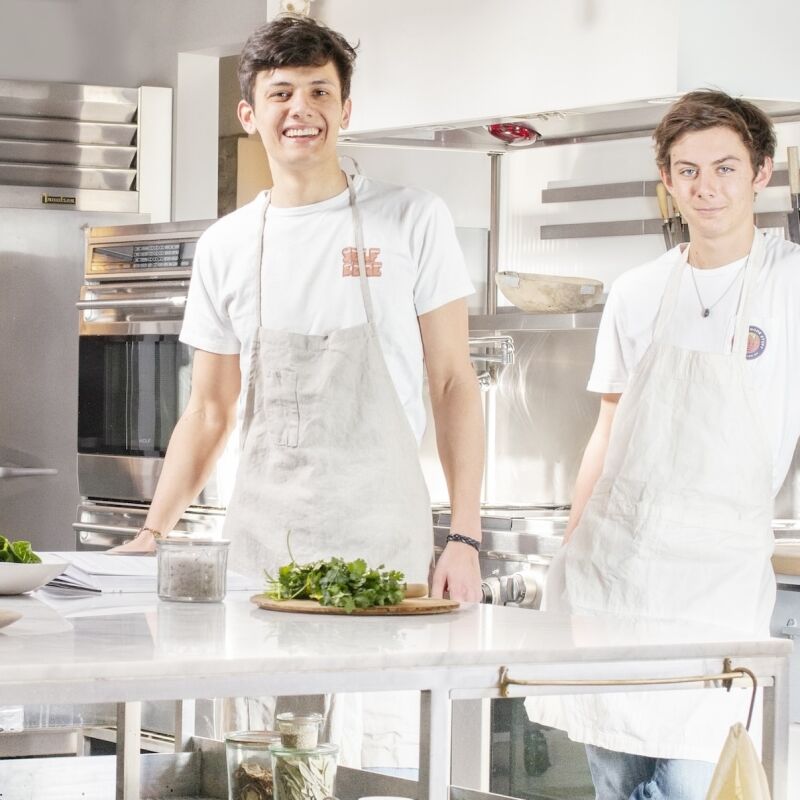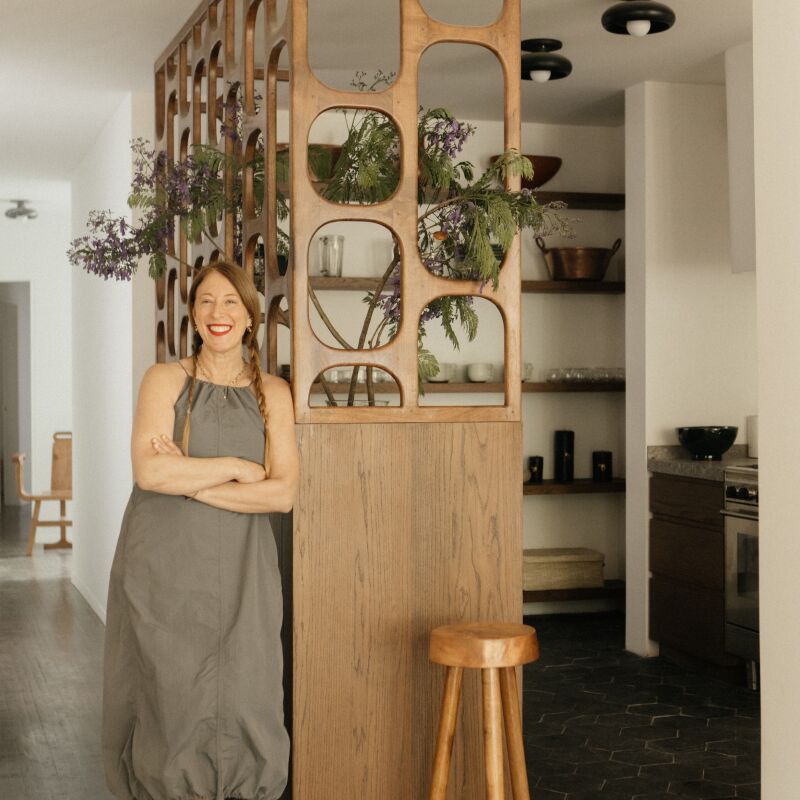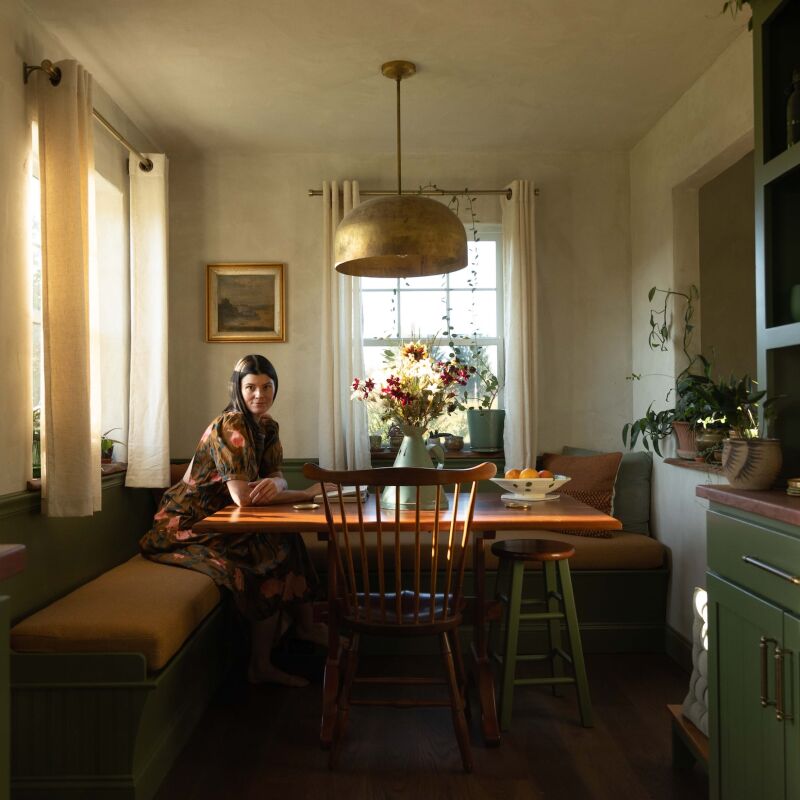Meet the new Mainers: Katee Lafleur and Andrew White, the thirtysomething couple running an under-the-radar farm in the tiny town of Montville, Maine. It might seem like an out-of-the-way place for one of the most striking interiors we’ve seen: not in Portland or one of Maine’s well-known, touristy small towns, but 24 miles inland from the seaside port of Camden, in Maine’s wooded, mountainous midcoast region, at the end of a two-mile-long dirt road, several miles from the nearest grocery. Driving north through increasingly rural backroads, past ponds and lakes, on my way to stay the night, I was grateful for GPS.
But the quietness you feel when you get out of your car at High Ridge Farm belies a thrumming level of activity: In true Maine do-it-yourself fashion, Lafleur and White run a self-sustaining farm, continually strip and update the old farmhouse, let guest rooms on Airbnb, and serve land-to-table tacos on Fridays and community dinners monthly in the restored early-19th-century barn—all with a sense of reverence for the Maine land.
The couple found the 35-acre property on Maine FarmLink, a division of Maine Farmland Trust, when they were living in Vermont and looking to make a move. “We felt like we were suddenly in on the secret that is the midcoast of Maine,” Lafleur says. As they set about tilling the land—they grow vegetables, herbs, and flowers, and raise chickens and woodland hogs—they also turned their attention to the 1835 farmhouse, drawing from instinct and learning as they went. “I was drawn to the simplicity and bare-bonedness,” Lafleur says. “That was part of why the price was accessible, while also affording us the opportunity to work with a mostly blank slate, to strip down the rooms to a point where the craftsmanship and history of the structure could be accentuated.” They took the walls down to the plaster, sourced extraordinary vintage finds from Craigslist and Goodwill, and added hides and bleached-white bones, relics of their butchered animals. The result: stripped-down and striking interiors that, like the farm, are a constant work in progress.
Here’s a look inside, captured on the stillest, hottest day of the summer.
Photography by Greta Rybus for Remodelista; styling by Annie Quigley.

When White and Lafleur found it, the old farmhouse had blue trim and brightly painted interiors (see “Before”); some exterior walls needed replacing, something the couple has taught themselves how to do “one room at a time, as structural issues necessitate.” They added the standing-seam metal roof last summer: “It’s a common, practical option in this climate,” Lafleur says. “In the winter, when the sun hits the roof, any accumulated snow slides down in these neat sheets.”
Lafleur and White have no formal background in construction or design, but they’re guided by their work as modern farmers. “There’s no separation for me in the tending of an indoor space and the tending of our land as a farmer,” Lafleur says. “Both inform the other and are guided by principles of intuition, careful observation to a surroundings’ needs, nimble problem solving, and an astute eye for details. In that way, I look at my home as a space in flux, like the seasons, that needs tending to perform its proper functions. A gut feeling leads my careful consideration of objects and their spatial needs, but like everything, that feeling is being honed and shifted all the time.”

In the large kitchen, shown here, Lafleur and White painted Valspar’s Swiss Coffee over existing wallpaper. The couple works slowly, room by room, and updating the kitchen is their next project. “We’re a farm that is selling our diverse products through prepared food and, thus, hospitality, eaten on-site,” Lafleur explains; to accommodate the prep needed for their increasingly popular from-the-land dinners, they’re planning on replacing the wall on the left, adding more windows and a new wood floor, and replacing the existing appliances that came with the house with industrial-grade versions.
For now, the kitchen is fitted with a mix of vintage and industrial finds: a hutch, found in the house, pairs with industrial metal shelving (at left) and a Hobart meat slicer (on the floor at right) that’s used to thinly slice the couple’s farm-raised charcuterie and salumi.

The couple eats mainly what they produce, and as a result they put out little waste: an antique basket serves as trash bin for any small scraps. Above it is Lafleur’s collection of silver flatware: “I’ve been buying pieces for one dollar each at flea markets and antiques stores over the past decade,” she says.




When they moved in, the front room was clad in cedar shingles, which the couple stripped down to reveal old lath and horsehair plaster. The floors are local pine, and a black-and-white photograph on the right is an old shot of the farmhouse (note that wall: it’s particleboard, for now). Alliums hang from the rafters: “Hanging in bunches is the way I cure the onions so that they store well for the year come,” Lafleur says. “Also, I just love looking at them hanging in the rafters, and they’re easily accessible there when we need to pull one for use.”

The floors are original: “They show signs of a history of painting and sanding, but we love them as-is,” Lafleur says.

Note the small inset compartment behind the couch: The couple isn’t sure what it was used for—more kindling storage, perhaps.

“The back bedroom is one of the only nearly ‘completed’ rooms,” Lafleur says. She describes the involved DIY process: “We pulled out the drop ceiling, revealing the beams, and took a crowbar to the laminate wallboards that were painted neon orange. We demoed the entire north wall, taking down and replacing all studs and the rotted sill that ran through to the bathroom. Andrew and our friend Asa Irons rebuilt the wall, and Andrew re-lathed the walls—a labor of love. Another friend helped with re-plastering the walls with the traditional mixture we made with our feet out front: We chipped straw and mixed it with powdered clay, water, and sand. The finish is a couple of coats of lime wash.” The black Andersen windows are new.

Gauzy white cotton curtains, a budget find from World Market, add a ghostly quality throughout the house. On the day we visited, a hot breeze billowed them into the rooms and draped them over the furniture.



The “headboard” is an existing red-brick fireplace, painted a glossy black. Lafleur found the brass lamps in two separate thrift shops over the past few years; each was five dollars.


Lafleur has an affinity for mirrors and uses them in unusual ways throughout the house: “I’m drawn to heavy, unusual, and beveled glass mirrors, and have picked them up anywhere from goodwill to flea markets across the country,” she says.


White replaced the floor with local white oak, stained dark, and built the vanity himself out of a pine slab and cast iron brackets from Treasures and Trash Barn in Searsport. The sink was a five dollar find from the Habitat for Humanity Restore; Lafleur sourced the mirror and sconces from goodwill and eBay and the woven mat from Craigslist.

The tile is the White Glossy 4×16 Inch Glazed Ceramic Wall Tile from Home Depot. The couple preserved the built-in hutch at left: originally used as a pantry, they use it for linen storage.

Lafleur found the basket at right at the Habitat for Humanity Restore in Portland; the couple keep their clothes in it, “in lieu of closet space,” they say.


Lafleur kitted out a glass orb with a lamp base and bulb from Amazon to make the light at right. The white glass lamp at left is from eBay: “I’ll occasionally search for midcentury lamps under $100 and this one was a particular score.”
Not pictured: a painting of the barn on a ranch in Petaluma, California, where Lafleur used to live, by friend and painter Scott Cooper.

Now, the barn has become a gathering place for a community of young people, families, and farmers in the Midcoast region: Lafleur and White serve from-the-land dinners once a month on Sundays and host taco nights every Friday. They believe in serving their food where it’s grown: “The taco is the vessel through which we sell everything we grow and raise, process, and put up,” they explain; they grow and make each tiny component—the pastured meat, the braise it’s cooked in, the tomatillos and jalapeños for their salsa verde, the lettuces and scallions on top, and, soon, the corn for the tortillas. Also on offer: their “foraged, wild-fermented” cider, with apples sourced from old orchards in the area, then pressed in the barn and bottled. This year, they’re serving the bottling from their first year on the farm, also available in their tasting room. “What you see on the land, you’ll find on your plate—and in your glass,” they say. (For more info, see the food and drink offerings here.)

Before, and In Process




Maine is on the rise. A few more of the projects we’ve been tracking lately, some of the most artful we’ve seen:
- The Soot House: Conjuring the Ghosts of Old New England on Spruce Head in Maine
- The New New England: A 1754 Cape on Spruce Head in Maine
Frequently asked questions
What is High Ridge Farm in Montville, Maine?
High Ridge Farm is a 100-year-old farmhouse located in Montville, Maine that has been renovated on a tight budget with a mix of DIY and thrifted materials.
What was the inspiration behind the renovation of High Ridge Farm?
The inspiration behind the renovation of High Ridge Farm was to create a modern and comfortable living space while preserving the historic elements of the farmhouse.
How was the renovation of High Ridge Farm carried out on a tight budget?
The renovation of High Ridge Farm was carried out on a tight budget through a mix of DIY and using thrifted materials. The owners also did a lot of the work themselves to save money on labor costs.
What kind of materials were used in the renovation of High Ridge Farm?
A mix of new and thrifted materials were used in the renovation of High Ridge Farm. For example, the kitchen cabinets were thrifted and repurposed while new fixtures were installed throughout the house.
What are some of the unique features of High Ridge Farm?
Some of the unique features of High Ridge Farm include the original shiplap walls and exposed ceiling beams in the living room, as well as the custom built-in bookshelf in the hallway.
What is the location of High Ridge Farm?
High Ridge Farm is located in Montville, Maine, surrounded by scenic countryside and nearby lakes.

















Have a Question or Comment About This Post?
Join the conversation